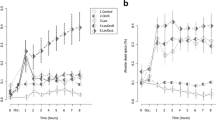Summary
Studies on gas exchange in pulmonary embolism are not numerous. A few of them have been performed in experimental animals [4]. The methods employed comprise the determination of gas exchange parameters [14], including the physiologic dead space [1], and the multiple inert gas elimination technique [2, 8, 10].
Furthermore, not much effort has been made to relate topographical alterations of ventilation and blood flow, detected by external counting of radioactive tracers, to ventilation/ perfusion (V˚A/Q˚) disturbances responsible for impaired gas exchange in pulmonary embolism.
This paper reports data on pulmonary gas exchange, V˚A/Q˚ distribution by inert gas elimination, and regional lung function by ventilation and perfusion scan in human pulmonary embolism.
Similar content being viewed by others
Author information
Authors and Affiliations
Rights and permissions
About this article
Cite this article
Giuntini, C., Santolicandro, A., Prediletto, R. et al. Mechanisms of ventilation-perfusion mismatch and hemodynamic alterations in acute and chronic pulmonary embolism. Intensivmed 37 (Suppl 1), S033–S038 (2000). https://doi.org/10.1007/s003900070004
Issue Date:
DOI: https://doi.org/10.1007/s003900070004




